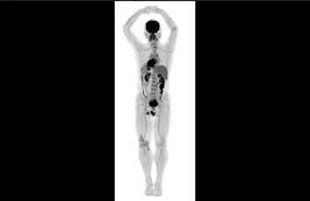- Home
- Editorial
- News
- Practice Guidelines
- Anesthesiology Guidelines
- Cancer Guidelines
- Cardiac Sciences Guidelines
- Critical Care Guidelines
- Dentistry Guidelines
- Dermatology Guidelines
- Diabetes and Endo Guidelines
- Diagnostics Guidelines
- ENT Guidelines
- Featured Practice Guidelines
- Gastroenterology Guidelines
- Geriatrics Guidelines
- Medicine Guidelines
- Nephrology Guidelines
- Neurosciences Guidelines
- Obs and Gynae Guidelines
- Ophthalmology Guidelines
- Orthopaedics Guidelines
- Paediatrics Guidelines
- Psychiatry Guidelines
- Pulmonology Guidelines
- Radiology Guidelines
- Surgery Guidelines
- Urology Guidelines
EXPLORER-World's first 3D total-body scanner developed

UC Davis scientists Simon Cherry and Ramsey Badawi have developed world's first medical imaging scanner EXPLORER that can capture a 3-D picture of the whole human body at once. It will be able to evaluate what is happening in all the organs and tissues of the body simultaneously. The technology will have countless applications, from improving diagnostics to tracking disease progression to researching new drug therapies.
EXPLORER is a combined positron emission tomography (PET) and x-ray computed tomography (CT) scanner that can image the entire body at the same time. Because the machine captures radiation far more efficiently than other scanners, EXPLORER can produce an image in as little as one second and, over time, produce movies that can track specially tagged drugs as they move around the entire body.
For the first time, an imaging scanner would quantitatively measure blood flow or how the body takes up glucose everywhere in the body. The researchers visualize using the scanner to study cancer that has spread beyond a single tumour site, inflammation, infection, immunological or metabolic disorders, and many other diseases.
"While I had imagined what the images would look like for years, nothing prepared me for the incredible detail we could see on that first scan," said Cherry, distinguished professor in the UC Davis Department of Biomedical Engineering. "While there is still a lot of careful analysis to do, I think we already know that EXPLORER is delivering roughly what we had promised.
Badawi, chief of Nuclear Medicine at UC Davis Health and vice-chair for research in the Department of Radiology, said he was dumbfounded when he saw the first images, which were acquired in collaboration with UIH and the Department of Nuclear Medicine at the Zhongshan Hospital in Shanghai.The first images from scans of humans using the new device will be shown at the upcoming Radiological Society of North America meeting, which starts on Nov. 24th in Chicago.
"The level of detail was astonishing, especially once we got the reconstruction method a bit more optimized," he said. "We could see features that you just don't see on regular PET scans. And the dynamic sequence showing the radiotracer moving around the body in three dimensions over time was, frankly, mind-blowing. There is no other device that can obtain data like this in humans, so this is truly novel."
The scanner has been developed in partnership with Shanghai-based United Imaging Healthcare (UIH), which built the system based on its latest technology platform and will eventually manufacture the devices for the broader healthcare market.
Badawi and Cherry first conceptualized a total-body scanner 13 years ago. Their idea was kick-started in 2011 with a $1.5 million grant from the National Cancer Institute, which allowed them to establish a wide-ranging consortium of researchers and other collaborators. And it got a giant boost in 2015 with a $15.5 million grant from the NIH. The funding allowed them to team up with a commercial partner and get the first EXPLORER scanner built.
Cherry said he expects EXPLORER will have a profound impact on clinical research and patient care because it produces higher-quality diagnostic PET scans than have ever been possible. EXPLORER also scans up to 40 times faster than current PET scans and can produce a diagnostic scan of the whole body in as little as 20-30 seconds.
Alternatively, EXPLORER can scan with a radiation dose up to 40 times less than a current PET scan, opening new avenues of research and making it feasible to conduct many repeated studies in an individual, or dramatically reduce the dose in pediatric studies, where controlling cumulative radiation dose is particularly important.
"The tradeoff between image quality, acquisition time and injected radiation dose will vary for different applications, but in all cases, we can scan better, faster or with less radiation dose, or some combination of these," Cherry said.
UC Davis is working closely with UIH to get the first system delivered and installed at the EXPLORER Imaging Center in leased space in Sacramento, and the researchers hope to begin research projects and imaging patients using EXPLORER as early as June 2019. The UC Davis team also is working closely with Hongcheng Shi, director of Nuclear Medicine at Zhongshan Hospital in Shanghai to continue and expand the scope of early human studies on the scanner.
"I don't think it will be long before we see at a number of EXPLORER systems around the world," Cherry said. "But that depends on demonstrating the benefits of the system, both clinically and for research. Now, our focus turns to plan the studies that will demonstrate how EXPLORER will benefit our patients and contribute to our knowledge of the whole human body in health and disease."

Disclaimer: This site is primarily intended for healthcare professionals. Any content/information on this website does not replace the advice of medical and/or health professionals and should not be construed as medical/diagnostic advice/endorsement or prescription. Use of this site is subject to our terms of use, privacy policy, advertisement policy. © 2020 Minerva Medical Treatment Pvt Ltd